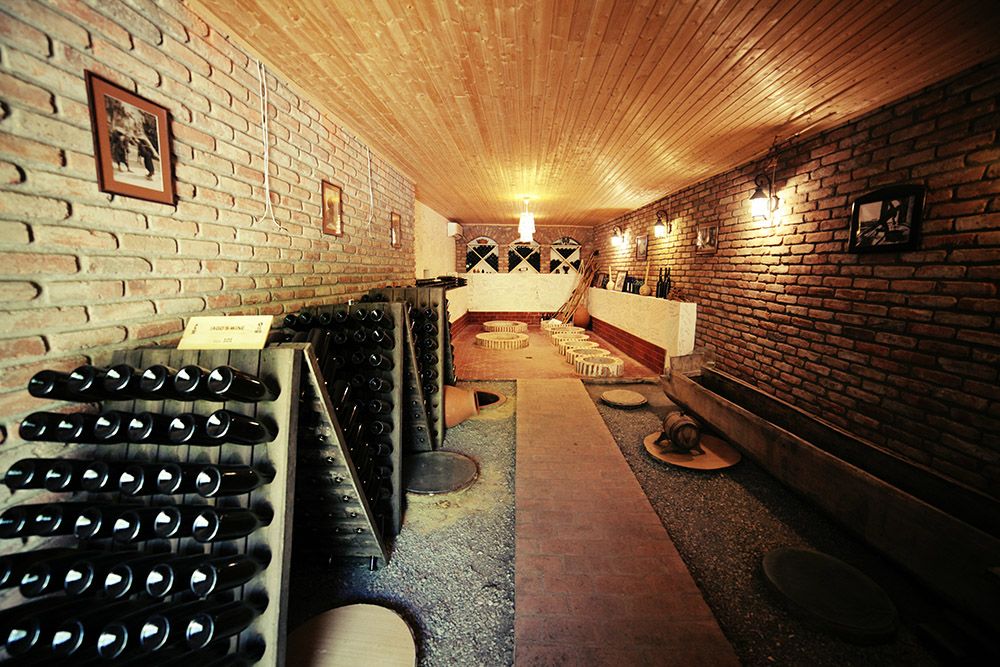
Iago Bitarishvili - Master of the Kvevri
4 min read
Iago Bitarishvili from Iago Winery makes his wines in the East of Georgia and is a master of the kvevri (a.k.a. qvevri) - large earthenware vessels that are traditionally used for making orange wines. The winemaker has 22 kvevries of various sizes buried in his cellar. In this article, he explains the technicalities of the process in detail.

"I harvest in October. But I always start washing my kvevries in August. Maybe every day I clean the kvevries because washing is a long process - we need a hygienical situation.
It’s important how we store our empty kvevries because we get problems when they are empty. The kvevri is clay and clay has porosity so sometimes bacteria gets inside. Cleaning the kvevries is hard work. All Georgian people who make kvevri wine are very skinny!
We wash the walls with water, and the second time with ash or limestone, then an acid like lemon and water. Then we pump out the water by hand. You want it to dry out, but it's impossible to get it 100%.
We need to finish the cleaning a maximum of one day before harvest. Then we put all the grapes with skin and stems and seeds - everything goes into the kvevri. We just crush it a little bit but don’t separate anything. We don't fill the kvevri because we need around 20-30% of it empty because during fermentation the grapes rise up. We don't close the kvevri.
We use the bigger kvevries for fermentation - around 2000 liters capacity. The size of the kvevri [influences] the fermentation temperature and the filtration process. In a small kvevri, for example 300 or 500 liter capacity, when we put all the grapes with skin and stems there is not enough space to separate skin and stems and wine. We need a bigger and longer kvevri - only like this does the process of filtration go very well.
After one or two days the natural fermentation process starts. It lasts around two weeks. Every day we use a big wooden stick to punch down - two, three or four times a day. We punch down because it's important. First of all, it's for temperature - because with high temperatures the bunches always go up and in low temperatures they stay down. And for activation of the yeast. The temperature is natural because our kvevries are underground. During the fermentation it's warm and during the storage it’s cold.
When the fermentation finishes after around two weeks, we take the wine from another kvevri and fill up [the first kvevri]. We might start with eight kvevries but after after the fermentation we will be have four or five full kvevries. The other kvevries will be empty - just skin and stems.

We then wait for a second fermentation which is also important - the malolactic. With Georgian kvevries, when they are underground during the alcoholic fermentation the soil keeps the high temperature and the second fermentation always starts very well naturally and continues - depending on the level of acidity -from around three weeks to one month.
When the second fermentation finishes it will be around the end of December. Only after that do we close hermetically and wait a couple of months for more maceration.
"In a longer maceration over four, five or six months many different ingredients go from the skin to the wine - phenols, tannins - and the wine changes color and taste."
In a longer maceration over four, five or six months many different ingredients go from the skin to the wine - phenols, tannins - and the wine changes color and taste. All these ingredients work like natural conservants and we don't need to use the sulfur - or just a little bit.
The skin and stems slowly go down in the kvevri over a couple of months. We call it a natural filtration process. And finally, after six months, we have naturally filtered wine. When we open the kvevri, we have absolutely clean wine and we just pump just the juice into smaller kvevries.
I don't like to mix the wine from different kvevries. Why? Because it's a same grape, the same day of the harvest. Every kvevri wine is a little bit different. When I sell them, sometimes people like number six kvevri or number one kvevri - it's like this.
"I love this because of the natural process and because of the natural philosophy."
I use this technology not only for my history, not only to continue this tradition - although of course it's important for me. But I love this because of the natural process and because of the natural philosophy.
Of course, we could change the time of the maceration or use only the skins. But why? I'm absolutely sure everything is important. If you believe in this technology you need to believe in everything.
For example, sometimes it's dangerous to use stems because they are green and sometimes very spicy. But what's the problem? We can take the good grapes and wait a little later to harvest the stems, which will then also be brown.
The stems are important because when people use only skins the filtration process does not go very well because the skins don’t go down separately. When we have the stems it goes down together, very slowly. It's a natural process.
We never move the kvevri because they are underground. It's difficult to move them because it means you need to destroy all your cellar and build it again."


